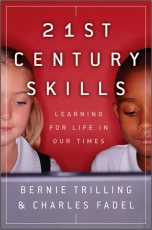 Excerpt
from 21st Century Skills: Learning for Life in Our Times
Excerpt
from 21st Century Skills: Learning for Life in Our Times
by Bernie Trilling & Charles Fadel
Learning Past and Future
By Bernie Trilling & Charles Fadel,
Authors of 21st Century Skills: Learning for Life in Our Times
We are currently preparing students for jobs that don't yet exist . . . using technologies that haven't yet been invented . . . in order to solve problems we don't even know are problems yet.It happened quietly, without fanfare or fireworks. In 1991, the total money spent on Industrial Age goods in the United States -- things like engines and machines for agriculture, mining, construction, manufacturing, transportation, energy production, and so on --was exceeded for the first time in history by the amount spent on information and communications technologies: computers, servers, printers, software, phones, networking devices and systems, and the like.
--Richard Riley, Secretary of Education under Clinton
The score? In 1991, "Knowledge Age" expenditures exceeded Industrial Age spending by $5 billion ($112 billion versus $107 billion). That year marked year one of a new age of information, knowledge, and innovation. Since then, countries around the globe have increasingly been spending more on making, manipulating, managing, and moving bits and bytes of information than on handling the material world's atoms and molecules.
This monumental shift from Industrial Age production to that of the Knowledge Age economy -- information-driven, globally networked -- is as world-changing and life-altering as the shift from the Agrarian to the Industrial Age three hundred and fifty
years ago.
Moving from a primarily nuts-and-bolts factory and manufacturing economy to one based on data, information, knowledge, and expertise has had a huge impact on the world's economies and our everyday lives. The sequence of steps to produce a product or service, the so-called value chain of work, has dramatically shifted, as shown in Figure 1.1.
Industrial economies are focused on turning natural resources such as iron and crude oil into products we use -- automobiles and gasoline. Knowledge economies turn information, expertise, and technological innovations into services we need, like medical care and cell phone coverage.
This of course doesn't mean that Industrial Age work will or can go away in the Knowledge Age -- manufactured products will always be needed.
It does mean that with increasing automation and the shifting of manufacturing (and its environmental impacts) to lowerwage, industrial-equipped countries such as China, India, and Brazil, industrial work in Knowledge Age countries will continue to decline and service-based knowledge work will continue to grow well into the 21st century.
But that's only one of a whole bundle of big changes that have arrived at our doorstep in the early part of the 21st century. And these changes will continue to make new demands on education as the century progresses.
As Thomas Friedman vividly reported in The World Is Flat: A Brief History of the Twenty-First Century and in Hot, Flat, and Crowded, the 21st century is challenging and reshuffl ing the very foundations of our society in new, powerful, and often alarming ways. For example:
- The world now has a truly global fi nancial and economic ecosystem. This highly interlinked system means that a disruption in one part of the world (such as a U.S. housing loan crisis) has dire consequences to economies everywhere.
- The growing disparity in the world between rich and poor leads to social tension, conflicts, extremism, and a less safe world for everyone.
- Global population has risen from 2.5 billion in 1950 to nearly 7 billion in 2009. This figure is expected to exceed 9 billion by 2050.
- Despite widespread poverty, increasing numbers of people are rising into middle-class lifestyles, which drastically increases their consumption of the earth's material and energy resources
- Increased consumption of resources is causing climate change and
other threats to the natural world and its global life-support systems.
But as the Chinese characters for the word crisis suggest, in times such as these, along with danger and despair come great opportunities for change and renewed hope.
One of education's chief roles is to prepare future workers and citizens to deal with the challenges of their times. Knowledge work -- the kind of work that most people will need in the coming decades -- can be done anywhere by anyone who has the expertise, a cell phone, a laptop, and an Internet connection. But to have expert knowledge workers, every country needs an education system that produces them; therefore, education becomes the key to economic survival in the 21st century.
To further understand what our times demand of education we must take a closer look at the changing world of 21st century work.
| Industrial Age Value Chain Extraction --> Manufacturing --> Assembly --> Marketing --> Distribution --> Products (and Services) Knowledge Age Value Chain Data --> Information --> Knowledge --> Expertise --> Marketing --> Services (and Products) |
The above is an adapted excerpt from the book 21st Century Skills: Learning for Life in Our Times by Bernie Trilling & Charles Fadel. The above excerpt is a digitally scanned reproduction of text from print. Although this excerpt has been proofread, occasional errors may appear due to the scanning process. Please refer to the finished book for accuracy.
Copyright © 2010 Bernie Trilling & Charles Fadel, authors of 21st Century Skills: Learning for Life in Our Times
